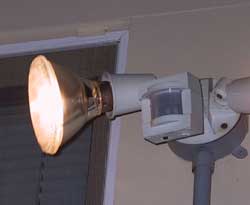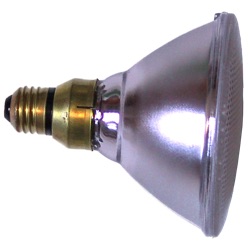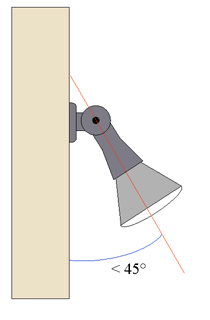Guides
On this page:
What are PAR lights?
 "PAR" stands for parabolic aluminized reflector and is a term applied to spotlights and floodlights commonly used by homeowners and small businesses.
"PAR" stands for parabolic aluminized reflector and is a term applied to spotlights and floodlights commonly used by homeowners and small businesses.
PAR fixtures are typically mounted on a movable neck with which you can aim the light where you need it. They are one of the most popular home "security" lights.
Despite the name differences, floodlights and spotlights are not significantly different. A spotlight casts its light nearly as wide and far as a floodlight, even though the name might imply greater light control.
 The Parshield® glare visor fits most outdoor PAR38 style bulbs, which have a 4.75" diameter with a rim as shown on the left. The Parshield® visor may not fit bulbs with a rounded rim, which is typical of indoor floods and many compact fluorescent bulbs even if labeled as "PAR38."
The Parshield® glare visor fits most outdoor PAR38 style bulbs, which have a 4.75" diameter with a rim as shown on the left. The Parshield® visor may not fit bulbs with a rounded rim, which is typical of indoor floods and many compact fluorescent bulbs even if labeled as "PAR38."
The Parshield® glare visor fits PAR38 bulbs with a rim. The following is an example of a bulb with a rim.
Unfortunately, the Parshield® glare visor does not fit every PAR38 style bulb available. Indoor PAR bulbs, some compact fluorescent models, and some outdoor PAR bulbs, have a smaller diameter even though they're labeled PAR38. Specifically, we have found that the glare visor does NOT work with:
- Philips indoor/outdoor PAR38 flood, 90 watt Halogena with part number 816263, from Home Depot. Other retailers might also sell this bulb.
Aiming
 | Aim your spotlights carefully to avoid sending light where it's not wanted. Light that travels out of the intended area can trespass onto neighbors' properties, shine through windows, create glare, and otherwise cause annoyance. Be a good neighbor, aim your lights carefully. Here are some recommendations:
|
Mounting
Mounting height is critical for effective lighting, but how high you mount a light is a trade-off.
If you mount a spotlight low, it will shine in your eyes and those of visitors to your home or business. To fill an area with light from a low-mounted spotlight, you will have to aim it nearly horizontally. Such a light will shine off your property more easily creating light trespass.
Mounting a light higher makes it less likely that light will shine in your eyes. Furthermore, you can aim the light at a more-downward angle, reducing the likelihood of light trespass. But, mounting a light too high makes maintenance difficult. Since light spreads out as it leaves the bulb, you'll need a brighter bulb and use more energy the higher you mount a light.
Here are some recommendations:
- Never mount a spotlight at eye level. Mount it at least 10 feet high, but not higher than you are comfortable climbing to replace a blown bulb.
- When possible, mount under the eaves of a porch or projection just above the first story.
- Mount the light so that as much as is possible it won't shine in your eyes or those of visitors. For example, mount a floodlight high in the middle of a walk that runs along the side of a building. In this way, it won't shine in the eyes of people arriving or leaving, but it will light their way.
Energy Efficiency
Operating your outdoor lights most likely costs more per year that it did to buy and install them. Keep these recommendations in mind to save energy and money.
Use a bulb of the appropriate wattage -- Don't use a 150-watt bulb if a 75-watt bulb would do the job. The 75-watt bulb uses half the electricity, thus costs half as much to operate. Try bulbs of different wattages in your lights to see which provides sufficient, but not too much, illumination.
Use a motion sensor control on your light -- Your lights will come on automatically when someone enters the area, alerting you and your neighbors to their presence. Furthermore, because lights will be on only when you need them, you use very little electricity.
Cost to operate a 150-watt bulb Dusk-to-dawn each night $114.90 / year Motion detector (one hour per night) $10.06 / year (at NYS average residential electricity rate of 16.7¢ per kilowatt-hour)
Use fluorescent PAR-style bulbs rather than incandescent bulbs -- A 23-watt fluorescent bulb puts out as much light as a 90-watt incandescent but uses less than a third of the electricity! Unfortunately, many of the new fluorescent PAR bulbs can't be used with motion detectors. Ultimately, you will probably use less electricity by adding a motion sensor control to your incandescent PAR fixture. But, if you need an always-on light, check out the new fluorescent PAR-style bulbs.